Books
Art Lovers, Here Are 7 New Non-Fiction Books to Add to Your Summer Reading List
Our writers and editors select their picks from recently published criticism, biographies, and graphic novels.

Our writers and editors select their picks from recently published criticism, biographies, and graphic novels.

Artnet News

Summer holidays and sunny weekends are the perfect moments to catch up on that part of the Venn diagram where the literary world and the art world intersect; in other words, the time is now to dive into great books about art.
Our staff has been collating recent publications of note, and we picked out seven new books—all engaging non-fiction—to keep you immersed in the real world while in summer mode.
Buy and read now, and enter the fall fair seasons with great and illuminating conversation starters. You’re welcome!
Candy Darling: Dreamer, Icon, Superstar (2024)
By Cynthia Carr
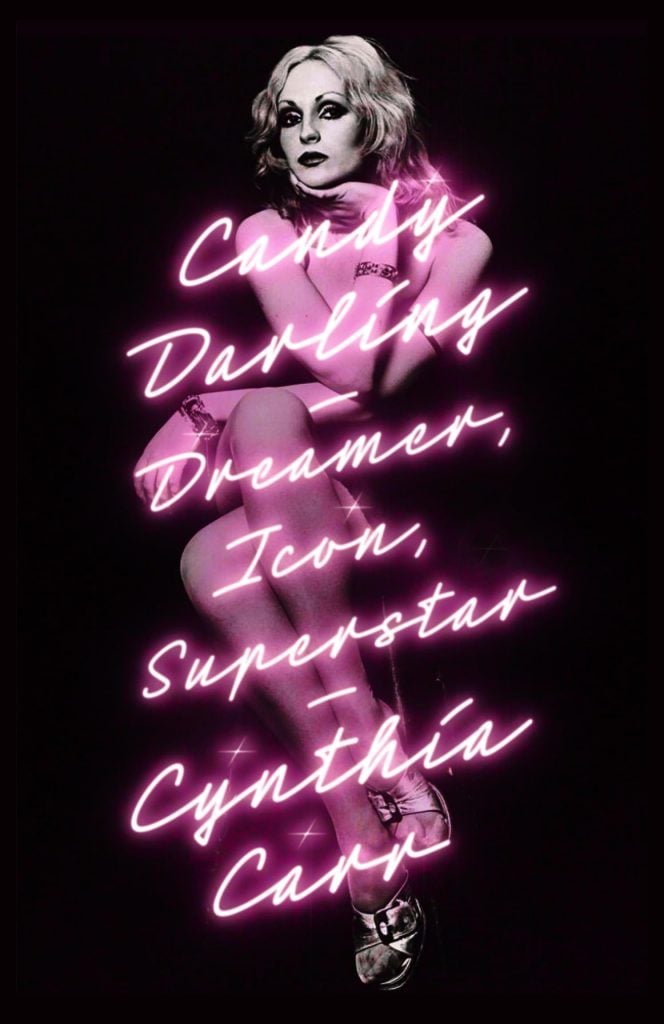
Candy Darling: Dreamer, Icon, Superstar (Macmillan, 2024).
Candy Darling longed to be a star. Following a turbulent childhood on Long Island spent in thrall to Kim Novak, she set out to wow Manhattan in the early 1960s. She achieved acclaim and adoration among the downtown demimonde for her sheer magnetism, but Hollywood fame remained frustratingly out of reach for an actor who was trans long before the phrase “gender binary” had even been uttered.
In the first biography to trace Darling’s brief, peripatetic life, Cynthia Carr affords her the compassion she rarely experienced. Unearthed here are Darling’s deep insecurities, but also the joy and affirmation that came with the construction of her identity. “You must always be yourself no matter what the price,” she once wrote to her cousin.
Darling’s creative flowering is also detailed: she made splashes in Off-Broadway plays (including in a minor Tennessee Williams work) and arthouse films; and was photographed by the likes of Richard Avedon, Robert Mapplethorpe, and Peter Hujar, whose image of Darling on her deathbed remains a masterpiece. But it was Andy Warhol who promised Darling stardom. She joined the ranks of his Superstars around 1967 and featured in his films, in a long association that did help burnish her name. Warhol loved her, too, in his way. When Bob Colacello informed the Pop artist that Darling had contracted leukemia, the writer remembered, “for the first and only time in the 17 years I knew him, I saw him cry.”
—Min Chen
Hello We Were Talking About Hudson (2024)
Edited by Steve Lafreniere
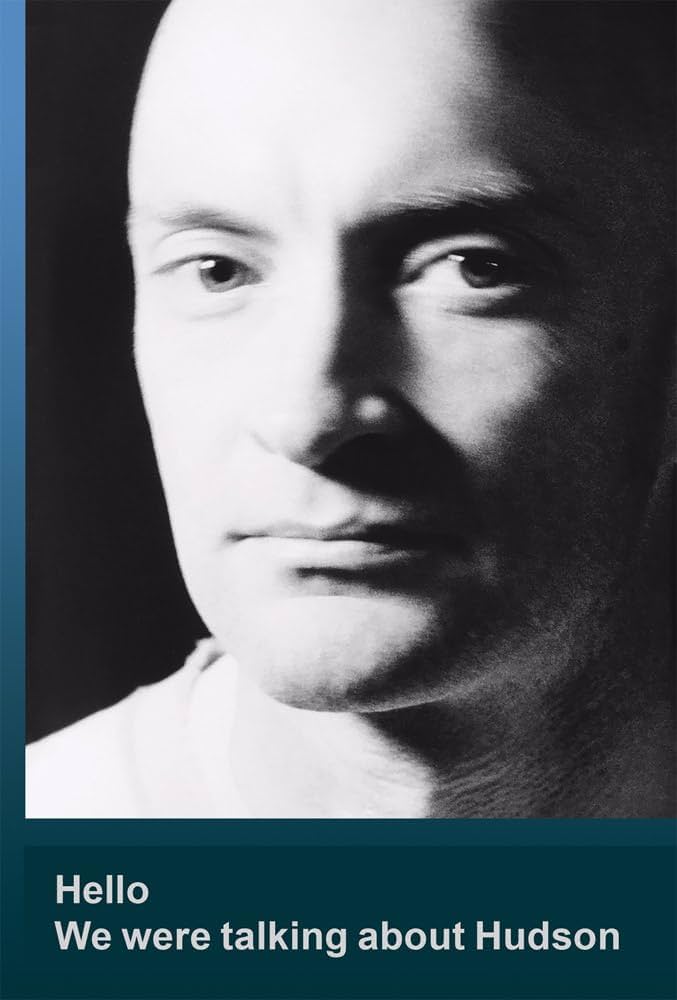
Hello We Were Talking about Hudson (Soberscove Press, 2024).
Few art dealers have had a batting average anywhere close to that of the mononymous art dealer Hudson. Over a nearly 30-year run—in Chicago from 1984 to 1988, then in New York until his death in 2014, at the age of 63—his Feature Inc. gallery hosted early shows by future stars like Richard Prince, Charles Ray, and Takashi Murakami, as well as future legends like B. Wurtz, Lily van der Stokker, and Nancy Shaver. Properly making sense of his legacy will require a full-dress survey at the National Gallery of Art or the Museum of Modern Art, but until then, we have this remarkable book, which includes interviews with some three dozen of his artists, associates, and admirers, along with eulogies and other writing. Feature Inc.’s longtime graphic designer, Steve Lafreniere, is its editor.
The remembrances are illuminating, moving, and candid. Showing with Hudson was “a rich experience,” Ray says, while explaining that his role “was less stable than a traditional art dealer’s.” Hudson had started out as a freewheeling performance artist, and the writer David Sedaris recalls an early piece in which he “massage[d] his ass,” adding that “I don’t know that I’d ever seen any performance like that.” For fellow Manhattan dealer Derek Eller, “Hudson showed that you could run a gallery any way you wanted. But I don’t think there will ever be another equivalent.”
What made him such a superb talent spotter? Hudson said of his approach, in lines that are quoted in the book by the artist and writer Steel Stillman: “The first thing is to be quiet, to drop my agenda or expectations, and listen. Then I soften my gaze. The eyes are aggressive, and once you realize they’re out there hunting, you can learn to tune them down and let what is out there come to you.”
—Andrew Russeth
Immediacy, or The Style of Too Late Capitalism (2024)
By Anna Kornbluh
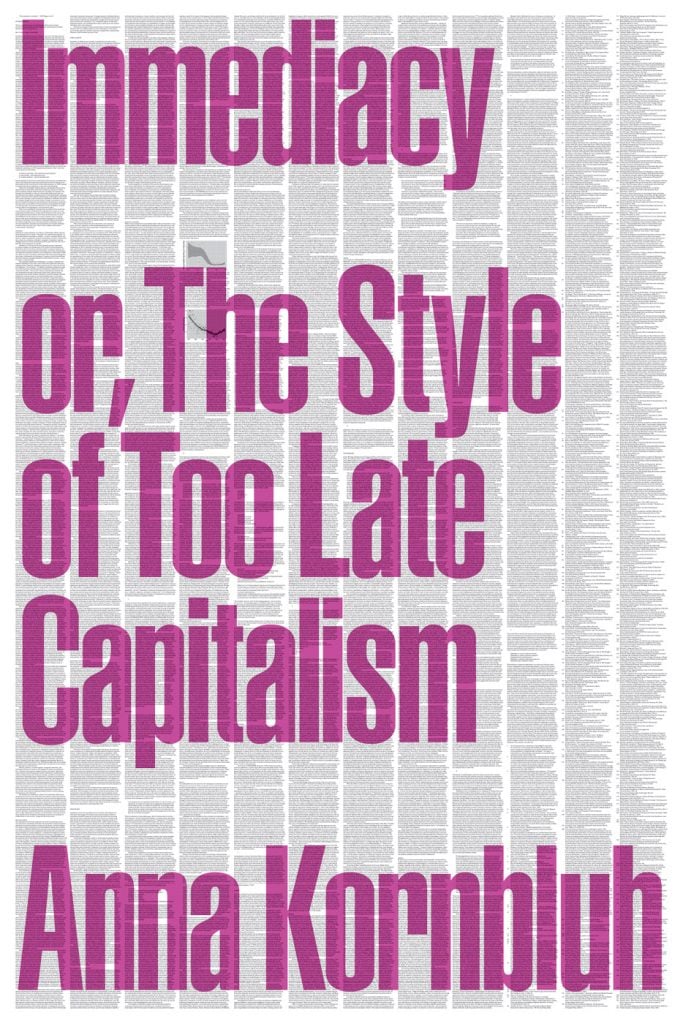
Immediacy, or the Style of Too Late Capitalism (Verso, 2024).
Kornbluh sets out to look at the drive towards “immediate” experience across a range of recent phenomena. She ends up producing one of the most useful books of art theory of the 2020s so far. This is a complex argument, drawing in everything from “immersive” art attractions, to the economics of just-in-time production, to “auto-fiction” in literature, to Uncut Gems. It’s also a gutsy argument, taking aim at more than one theorist who appears on ArtReview’s “Power 100” list of favorite thinkers.
In a world full of emergencies, immediate response may feel right—but Kornbluh argues that we can’t effectively respond to these emergencies without “mediation,” that is, without mental structures and social organizations that are slower and more complex than the relentless celebration of the first person and gut reaction allows or encourages. In weaving connections between developments in many diverse realms, she’s also role-modeling the mediation she’s talking about, in a way that actually delivers on the title’s playful promise to update Fredric Jameson’s very-influential Postmodernism, or the Cultural Logic of Late Capitalism.
The book seems to have gotten a bit of traction in art circles (Tank magazine dedicated its spring issue just to responses to Kornbluh’s thesis). Maybe ironically given its theme—though maybe not given its actual argument—I think Immediacy is a work whose influence will grow over time.
—Ben Davis
Like Love: Essays and Conversations
By Maggie Nelson
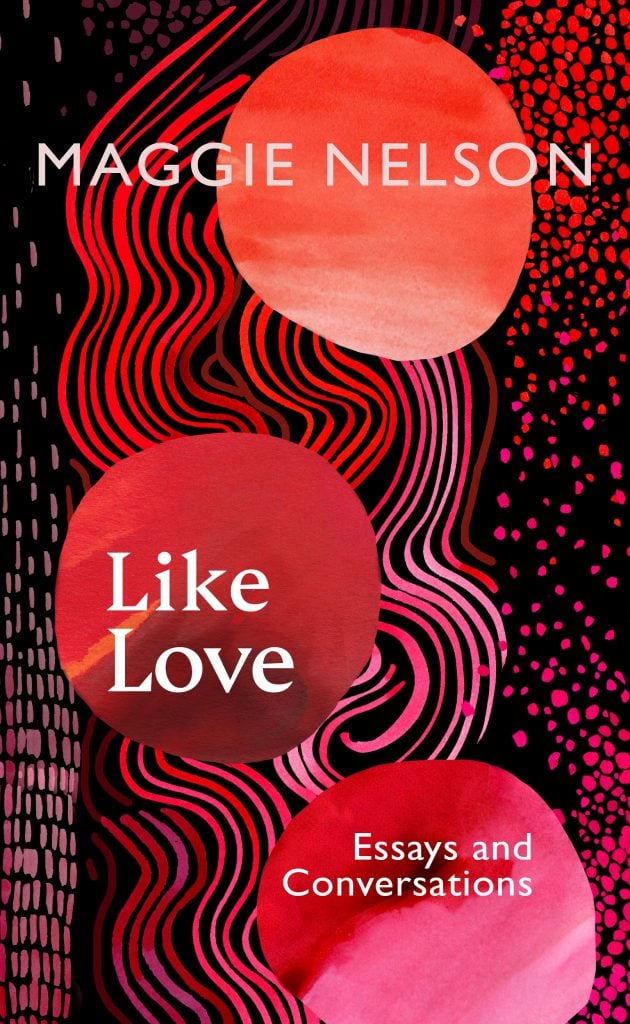
Like Love: Essays and Conversations published in the U.K. by Penguin’s Fern Press imprint. Photo courtesy of Penguin Random House.
The American writer Maggie Nelson has become best known for autobiographical essays thanks to the runaway success of her memoir The Argonauts (2015). In this robust collection of profiles, reviews, and essays, she instead takes the stance of a critic, but the power of a deeply personal perspective on art and literature still shines through thanks to Nelson’s unguarded and highly distinctive interpretations of her subjects. Though these are mostly fellow writers and theorists, a luxuriously long profile of Carolee Schneemann brings clarity to an often intimidating practice, investigating the artist’s intent—as well as her contradictions—with warmth and sensitivity while contextualizing these within the changing landscape of “feminist art.”
A shorter review of Kara Walker’s Event Horizon eschews the flattening narratives often applied to such a challenging work—in this case, a press statement describing it as “a struggle for freedom and opportunity”—in order to seek out its more ambiguous yet more profoundly emancipatory implications. A third essay celebrating the power of Sarah Lucas describes various ways in which the artist’s work affected Nelson at different points in her life.
–Jo Lawson-Tancred
Portrait of a Woman: Art, Rivalry, and Revolution in the Life of Adélaïde Labille-Guiard (2024)
By Bridget Quinn
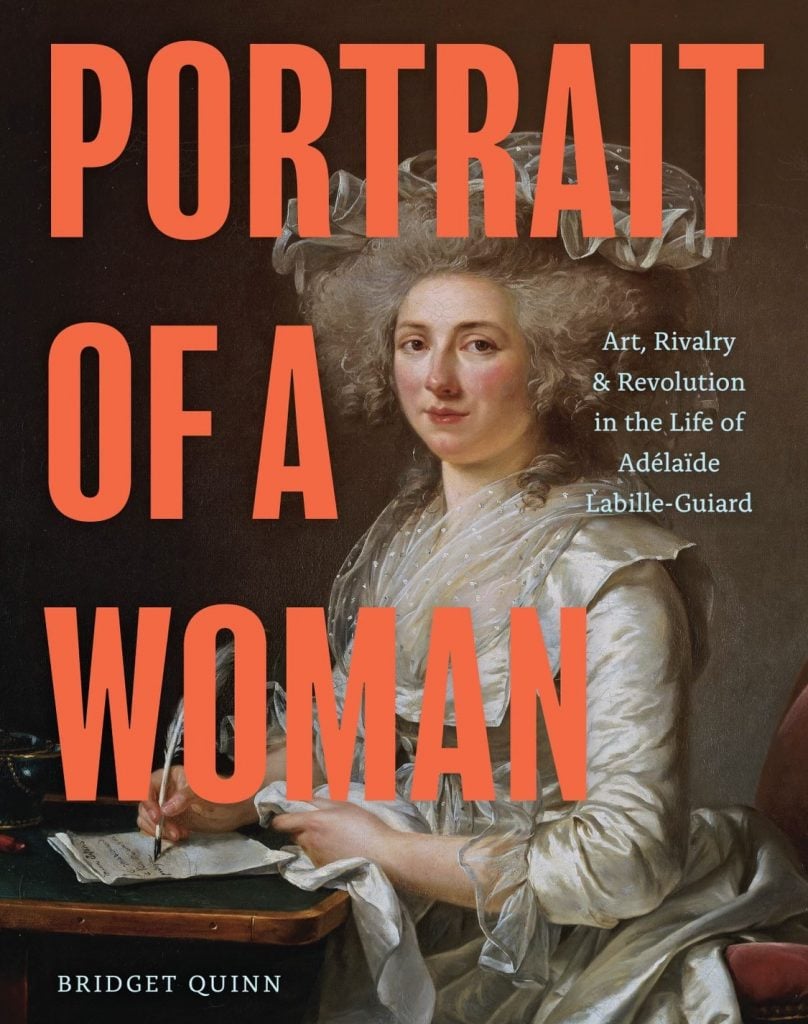
Portrait of a Woman: Art, Rivalry, and Revolution in the Life of Adélaïde Labille-Guiard (Chronicle Books, 2024)
Neoclassical artist Adélaïde Labille-Guiard steps out from the shadows in this delightful and insightful biography by Bridget Quinn. Born in Paris in 1749, the daughter of a shopkeeper, the young Labille-Guiard charted an incredible artistic course for a woman of her era. Overcoming numerous obstacles, Labille-Guiard would become the official portraitist of the royal court and a member of the exclusive Académie Royale.
As a leading artist of her generation, Labille-Guiard devoted herself to mentoring a generation of young women artists below her. Labille-Guiard left behind little writing though, and few firsthand accounts have survived the test of time; as a result, her story had nearly been lost to history.
But now Bridget Quinn is offering up a lively portrait of an artist of the Élisabeth Louise Vigée Le Brun caliber, weaving together art historical analysis, cultural context, historical record, as well as moments of fictionalized vignettes to offer a compelling and readable vision of Labille-Guiard’s life.
—Katie White
Becoming Modigliani (2024)
By Henri Colt, M.D.
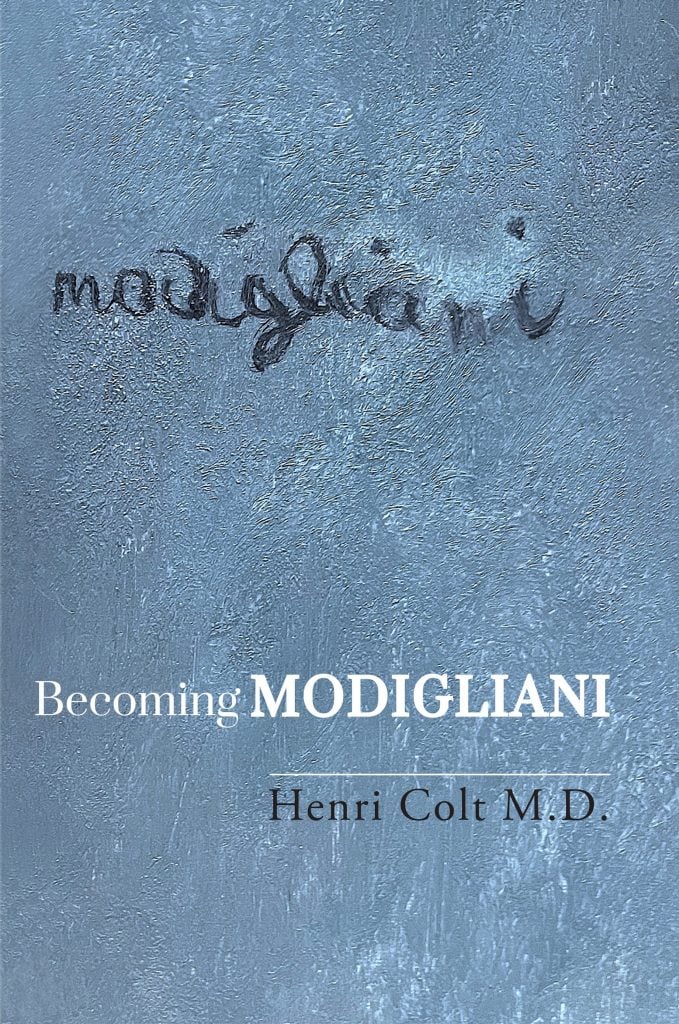
Becoming Modigliani (Rake Press, 2024)
Dr. Henri Colt, an internationally recognized lung specialist, and Professor Emeritus at the University of California, gets straight to the point in the introduction: “Does the world really need another book about Modigliani? The answer is yes.” Colt says this “tuberculosis-plagued, alcohol-abusing painter sculptor” has been examined from a range of angles but posits that “a critical view of the interplay between his illness, his environment, and the social fabric of 20th-century Paris is lacking.”
Colt is impassioned about the subject matter, which shines through in the writing. The Modigliani Project, a nonprofit organization devoted to promoting research and scholarship on the artist, even touted this unusual tome in its recent newsletter: “the uniquely medical approach to the story of Modigliani’s life struggling with tuberculosis has been very well received.”
—Eileen Kinsella
Zodiac: A Graphic Memoir (2024)
By Ai Weiwei with Elettra Stamboulis, illustrated by Gianluca Costantini
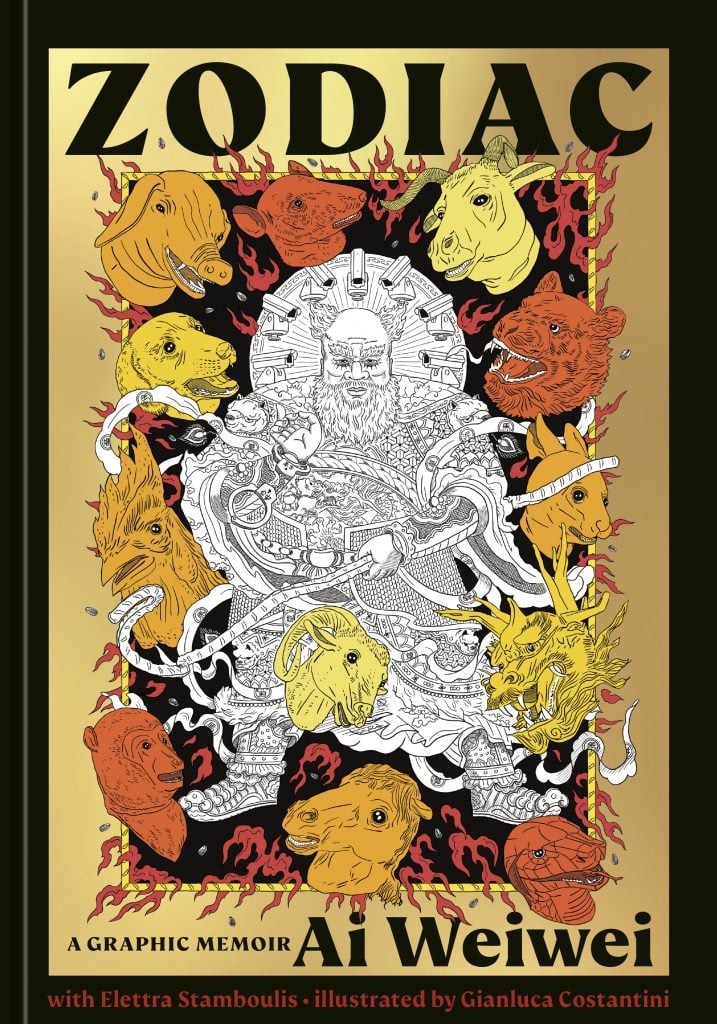
Zodiac: A Graphic Memoir (Ten Speed Graphic, 2024).
Though this isn’t Ai Weiwei’s first memoir (in 2021 he released 1000 Years of Joys and Sorrows: A Memoir, inspired by his 81-day detainment in China in 2011), ZODIAC takes a decidedly different tack. This fully illustrated graphic memoir is the artist’s firs and it is influenced by the government-approved comic books of his childhood.
Ai taps the potential of visual storytelling as well as the 12 Chinese zodiac signs to weave together a time-shifting narrative. Personal history, family stories, career moments, as well as broader reflections on freedom of expression and art as a conduit for exploring oneself intermingle through the book and not only offer insight into Ai himself but new perspectives on art and humanity as well.
—Annikka Olsen